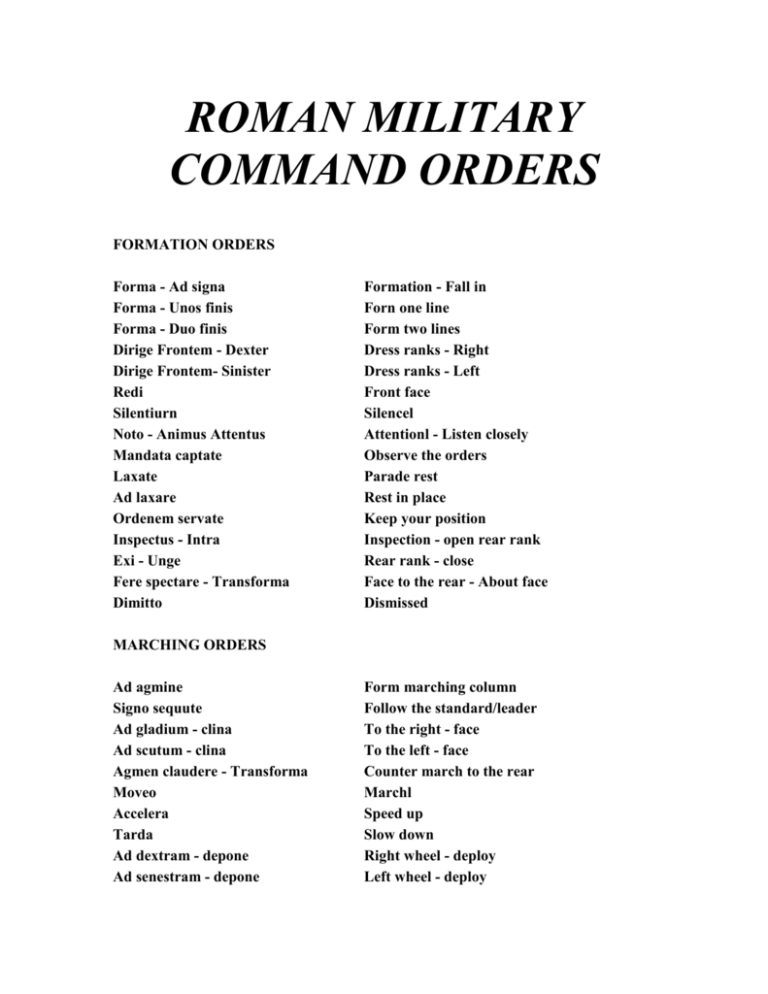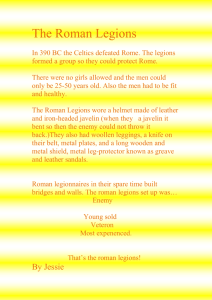ROMAN MILITARY COMMAND ORDERS
advertisement

ROMAN MILITARY COMMAND ORDERS FORMATION ORDERS Forma - Ad signa Forma - Unos finis Forma - Duo finis Dirige Frontem - Dexter Dirige Frontem- Sinister Redi Silentiurn Noto - Animus Attentus Mandata captate Laxate Ad laxare Ordenem servate Inspectus - Intra Exi - Unge Fere spectare - Transforma Dimitto Formation - Fall in Forn one line Form two lines Dress ranks - Right Dress ranks - Left Front face Silencel Attentionl - Listen closely Observe the orders Parade rest Rest in place Keep your position Inspection - open rear rank Rear rank - close Face to the rear - About face Dismissed MARCHING ORDERS Ad agmine Signo sequute Ad gladium - clina Ad scutum - clina Agmen claudere - Transforma Moveo Accelera Tarda Ad dextram - depone Ad senestram - depone Form marching column Follow the standard/leader To the right - face To the left - face Counter march to the rear Marchl Speed up Slow down Right wheel - deploy Left wheel - deploy Sin pie - dex pie Sin-sin-sin-dex-sin Consiste Left foot - right foot Left-left-left-right-left Halt! BATTLE ORDERS Ad aciem- Pugna - Celeriter Form Battle Lines! - Battle! - Quickly! Pila infige Plant your pilum (upright) Pila pone Lay down your pile Pila tolle Pick up your pilum Pila iace Throw your pilum Gladium stringe Draw your sword Gladium reconde Sheath your sword Parati - Oppugnare Ready! - Charge! Ad testudinem Form the Testudo Ad cuneum Form the Wedge Defendi altus Defend high Defendi inferius Defend low Defendi ad parati Defend at the ready Impetus Attack! Repulsus Drive back, repulse! Ave Caesar! Hail Caesarl Meus caparum Romanus-Ad Victoria! My Roman troops - To Victory! Cum gratia Centurio Marcus Caesar Exhorts His Troops (Ridpath illustration) Ever since Julius Caesar led his army into Rome and made himself military dictator, Roman emperors have relied on the military to secure their position and enforce their will. Not one to hide his light under a bushel, the 76-year old Caesar Augustus (Julius Caesar's adopted son) boasted of having used the military to impose a pax Romana (Roman peace) on much of the Western world. The whole of Italy of its own free will swore allegiance to me and...Africa, Sicily and Sardinia swore the same oath of allegiance....I brought peace to the Gallic and Spanish provinces as well as to Germany....I secured the pacification of the Alps from the district nearest the Adriatic to the Tuscan sea....I added Egypt to the empire....I recovered all the provinces beyond the Adriatic Sea towards the east....I formed colonies of soldiers in Africa, Sicily and Macedonia. Augustus' grandson Claudius extended the Empire to Britain and granted Roman citizenship to qualified persons from any part of the Empire, an Empire that reached its height during the reigns of the "five good emperors" (i.e., Nerva, Trajan, Hadrian, Antoninus Pius, Marcus Aurelius). In the 2nd century A.D. there were 3 legions in Britain, 1 in Spain, 4 along the Rhine, 11 along the Danube, 9 in the Near East and 2 in North Africa. Roman legions defended the imperial frontiers from the Scottish border to the deserts of Arabia, from the Danube to the Atlas mountains in northern Africa. The imperial army consisted of some 300,00 men, half of whom made up the legions or units that carried eagles as their standard. There were c.28 legions, with an average strength of 5000, each made up of 10 cohorts of c.500 men. Cohorts were divided into 6 centuries, each numbering c.80 men under the command of a centurion. Almost all infantry troops were recruited from the citizenry. (Generally, 100 to 200 of the troops were cavalrymen.) Auxiliary units of colonial troops drawn from the provinces backed up the legions. The auxiliary soldiers, who drew less than half the pay of the legionaries, were granted citizenship on their discharge. A legionary was protected by wooden shield, iron helmet and coat of iron mail and armed with "pilum" or javelin that he hurled when closing in on the enemy and a "gladius" or short sword used at close combat. During the many interludes of peace in the first two centuries of the empire, the welltrained troops labored on public works, e.g., building and repairing bridges, aqueducts and the great network of roads, all of which proverbially led to Rome. The most prestigious (and best paid!) troops served in the praetorian guard, the legion formed to protect the emperor. Caesar Augustus established this special guard, consisting of 9 elite cohorts, each consisting of c.500 men and based in Rome with the sole function of protecting the emperor. In 193 A.D. the praetorians assassinated Pertinax and declared that the throne would be auctioned off to whoever offered them the biggest bonus. The winner, Didius Julianus, was promptly overthrown after a reign of 66 days by Septimius Severus (the first Roman emperor of North African origin), who promptly killed the praetorians who had assassinated Pertinax and dismissed and exiled the remainder of the praetorian guard. Josephus wrote admiringly of the legionaries' excellence. "Their perfect discipline welds the whole into a single body; so compact are their ranks, so alert their movements in wheeling, so quick their ears for orders, their eyes for signals, their hands for tasks." Ranking of Soldiers auxiliary -- drawn from Roman colonies or provinces legionary -- the backbone of the Roman army (librarius legionus -- divisional clerk; a sort of cushy clerical job) signifer -- standard bearer optio -- sergeant cornicularius -- top sergeant centurion -- the lowest commissioned rank tribune -- generally a young aristocrat legatus -- commander of a legion (like a general in charge of a division) who had 6 tribunes as subordinates; these officers were generally drawn from the senatorial class) Of all Roman emperors, Marcus Aurelius took the most "hands on" approach in military affairs. Traveling from camp to camp on the far-flung frontiers, he personally led his armies and even found time between battles to write his famous Meditations. Rome's standing army remained unequaled for centuries. The Romans were especially expert at clever and speedy field maneuvers and the ancient art of siege warfare. Ramps, scaling ladders, mobile assault towers with galleries for archers, crossbowmen, stone slingers and javelin hurlers, giant catapults called "ballistas" or "onagers" capable of flinging projectiles 2000 feet or more and smaller catapults or "scorpios" capable of hurling heavy rocks or bags of small stones or iron darts (i.e., the ancient equivalent of shrapnel) were all part of their amazing bellicose weaponry. The soldiers methodically built fortified camps at the end of each day's march to protect against surprise attacks and serve as a refuges in case of defeat. The soldiers were so good that the Romans even found them to be their best weapon at sea: they equipped their galleys with a combination grappling hook/gangplank which both snared the enemy and enabled the infantry to board. With these tactics and the best siege techniques of the ancient world the Romans were able to best enemies ranging from Macedonian phalanx to barbarian hordes, the Carthaginian navy to the fortress of Alesia.







